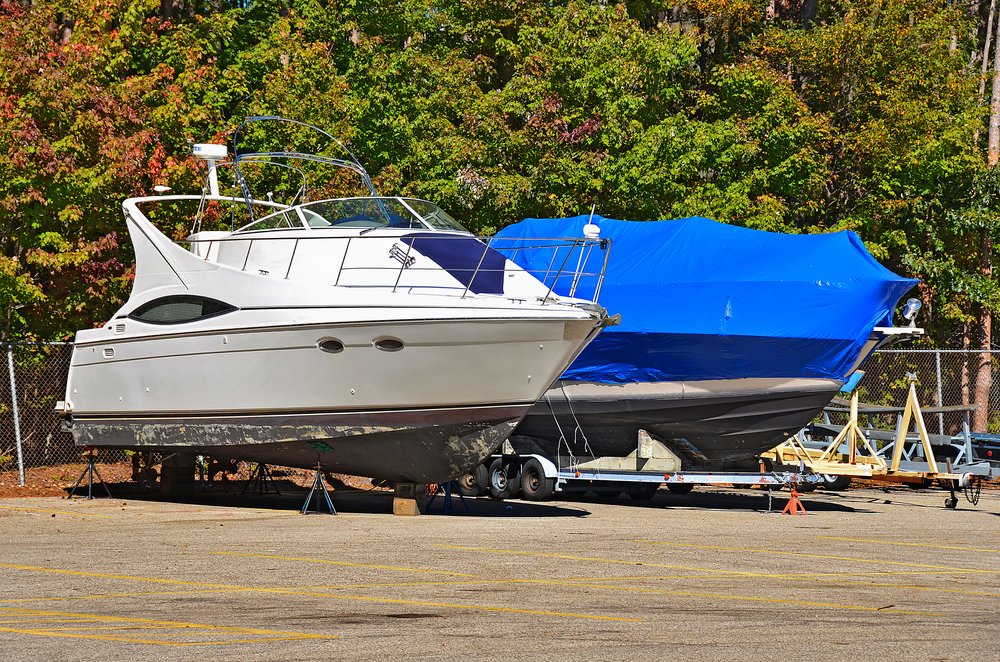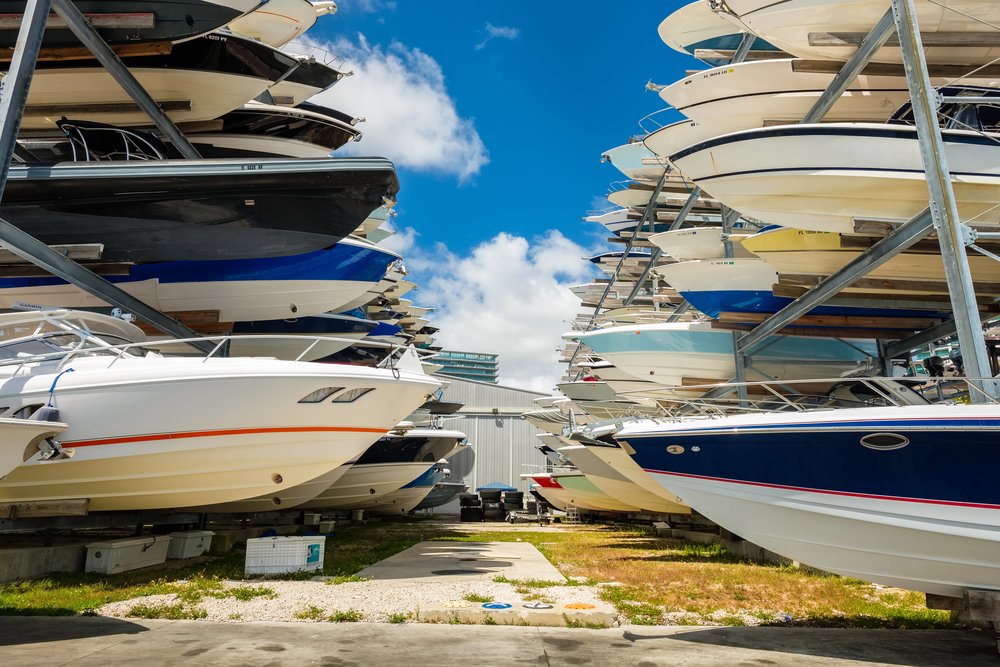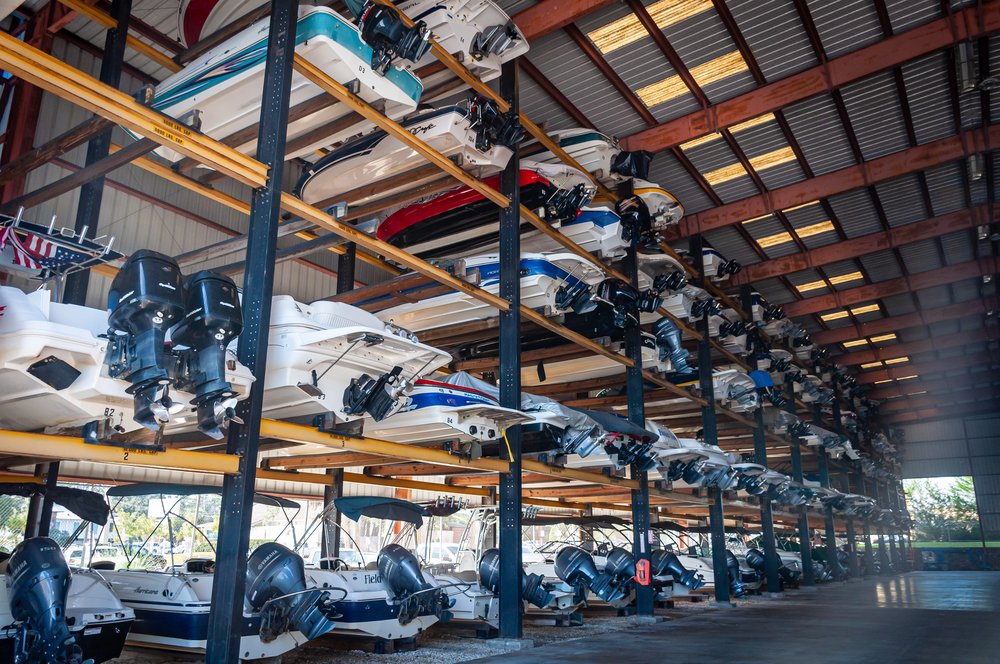Boat storage cost can run anywhere from $28 to $422 monthly based on the location, size, and type of storage you choose. At the time I started looking into boat storage options, the huge price differences caught me off guard.
Indoor storage gives your boat the best protection but comes at a premium – you’ll pay $21 to $28 per foot. The outdoor storage options are easier on your wallet at $20 to $50 per foot each season. The average storage costs tend to follow local market rates, and coastal areas charge by a lot more for boat storage. Boat owners in expensive regions might pay up to $200 per foot, which takes up much of their boating budget.
Boat Storage Cost Estimator
Calculate your estimated boat storage costs based on your specifications.
Step 1: Boat Dimensions
Step 2: Storage Type
Select the appropriate storage option for your vessel:
Step 3: Storage Duration
Select your preferred storage duration:
Step 4: Storage Location
Select the facility location type:
Step 5: Additional Services
Select any additional services required:
Boat Storage Cost Estimate
$0
per month
Vessel dimensions: 20ft × 8ft
Storage type: Outdoor
Duration: Monthly
Location: Coastal
Additional services:
This estimate is based on industry standard rates and may vary by specific facility. Contact your preferred storage provider for exact pricing.
Find Boat Storage Near MeThis piece breaks down what affects boat storage prices and shows you practical ways to cut costs while keeping your vessel safe and well-maintained.
Understanding Average Boat Storage Cost
The monthly cost to store a boat ranges from $50 to $400. These prices can change a lot based on several factors. Here's a detailed look at what affects these costs and what you might pay.
Monthly cost range by storage type
The type of storage you choose affects the price more than anything else. Each option gives you different levels of protection and ease of use:
- Outdoor uncovered storage: You'll pay $50-$150 per month. This simple option keeps your boat on land but leaves it exposed to weather.
- Outdoor covered storage: A middle option that costs $100-$250 monthly. Your boat stays protected from sun and rain while remaining outdoors.
- Indoor storage: The best protection from weather and theft costs $150-$500 per month. Your boat stays completely sheltered.
- Wet slips (marina storage): You'll pay $10-$20 per foot monthly. Your vessel stays in the water, ready to use.
- Climate-controlled storage: The premium choice costs $200-$400 monthly. Extra fees of $25-$50 apply for heating and air conditioning.
A 20-foot boat's storage can cost anywhere from $200 to $500 monthly depending on your choice.
Seasonal vs. year-round pricing
Storage costs change with seasons. Different pricing plans work for different usage patterns.
Winter storage costs more in northern areas where heated indoor storage becomes necessary. A 20-foot boat might cost $1,150 for winter indoor storage. Summer storage could run up to $1,600.
Year-round storage often costs less per month. You can expect to pay around $50 per foot yearly for simple indoor or covered storage. High-demand areas might charge up to $200 per foot.
Storage facilities offer seasonal and annual contracts. Seasonal contracts cost more monthly but give you flexibility. Annual contracts usually save you money each month.

Boat storage cost per month: what to expect
Your monthly costs depend on more than just storage type and season:
Boat size changes the price since bigger boats take up more space:
- Up to 20 feet: $50-$150 monthly
- 21-30 feet: $150-$300 monthly
- 31-40 feet: $300-$500 monthly
- Over 40 feet: $500+ monthly
Location makes a big difference in costs. Popular boating spots and cities charge premium prices:
- High-cost areas (NYC, San Francisco): Indoor storage $500-$600 monthly
- Mid-range markets (Miami, Los Angeles): Indoor storage $350-$400 monthly
- Lower-cost regions (Detroit, Dallas): Indoor storage $175-$250 monthly
Additional amenities can add to your monthly bill:
- Electricity: $25-$50
- Security cameras: $10-$50
- Gate access: $10-$25
- Maintenance services: $50-$150
Coastal regions charge more than inland areas because of high demand. A boat in San Francisco costs twice as much to store as the same boat in Detroit.
Your boat's size, storage choice, location, and needed amenities all work together to set your final monthly cost. Take time to review your needs and budget carefully.
Key Factors That Affect Boat Storage Prices
The cost of boat storage depends on several key factors. You'll make better decisions about storing your vessel if you know what affects the pricing.
Location and proximity to water
Your boat's storage location plays a huge role in what you'll pay. Storage facilities near popular waterways or boating spots charge premium prices compared to inland locations. This price difference boils down to basic supply and demand.
Coastal areas charge much more than inland locations because they have limited storage space. To cite an instance, cities with higher living costs and pricier real estate markets naturally have steeper boat storage rates. Space costs more in major metropolitan areas, which drives up the prices.
Boat size and dimensions
Storage costs are tied directly to your boat's size. Bigger vessels take up more space, and that means higher fees no matter what type of storage you choose.
A compact 10x15 space might be enough for small boats or jet skis, which keeps costs down. Sport boats or pontoons usually just need 10x20 or 10x30 storage spaces, which cost more. A good rule is to pick a storage space at least five feet bigger than your vessel for safe movement.
Type of storage: indoor, outdoor, covered
The type of storage you pick is another big factor in price:
- Indoor storage gives the best protection and costs the most. These facilities keep your boat safe from weather and other risks.
- Outdoor storage costs the least but leaves your boat exposed to the elements.
- Covered storage strikes a balance by protecting against sun, rain, and snow while being cheaper than indoor options.
Better protection means higher prices - that's the trade-off you'll face.
Climate control and added features
Climate-controlled facilities are worth thinking about in areas with extreme temperatures or high humidity. These spaces keep temperatures steady through heating and cooling systems.
This extra protection adds to your costs. Climate-controlled storage runs 10-20% higher than standard storage, usually adding $25-$50 to your monthly bill. The extra cost helps protect sensitive parts and materials, which could save you money on repairs later.
Security and access hours
Security measures and access times are big factors in storage pricing. Facilities with better security features – like 24/7 cameras, gated access, and staff on site – charge more.
Storage places that let you access your boat anytime also cost more than those with limited hours. This flexibility lets you get to your boat whenever you want, which really helps during busy boating seasons.
The most secure facilities with round-the-clock access charge the highest rates. These prices reflect their higher operating costs and the convenience they offer.
Many facilities offer month-to-month leases instead of long contracts. This works great if you're not sure how long you'll store your boat.
Knowing how these factors work together helps you find the best value. Cheaper outdoor storage might save money now, but weather damage could cost you more in repairs than you'd spend on indoor storage.

Comparing Different Types of Boat Storage
Boat owners must balance protection and cost when picking the right storage option. Different storage types come with their own set of advantages and challenges that affect your boat's condition and your budget.
Indoor storage: pros, cons, and pricing
Your boat gets the best protection from weather, UV damage, and theft with indoor storage. High and dry facilities store vessels inside, and they use forklifts to move boats in and out of warehouse-style racks. This level of protection helps your boat last by a lot longer since it stays away from harsh elements.
The premium protection doesn't come cheap—prices usually run between $50 to $200 per foot each season. A 10x20 indoor storage unit costs about $143 monthly.
You'll face some limitations with indoor storage. You need advance notice to get your boat out, and there might be height and weight limits. Peak seasons often mean waiting times. Many places won't let you work on your boat at their facility.
Outdoor storage: affordability and risks
Outdoor storage saves you money, costing about half what you'd pay for indoor options. Your boat stays in a secure, fenced area with simple security features.
The lower price tag means your boat faces more weather exposure, which speeds up wear and tear. Electronics and materials like leather or teak suffer from sun damage through oxidation. Weather elements like rain, snow, and hail can really take their toll over time.
Good covers or shrink-wrapping help alleviate these risks during off-seasons. Security remains a bigger concern with outdoor storage, though facilities usually have cameras and gates to protect your investment.
Covered storage: a middle-ground option
Covered storage gives you the best of both worlds. These facilities provide a roof and partial walls that protect your boat from direct sunlight and bad weather while keeping costs lower than fully enclosed options.
You get four walls and a solid roof without paying premium indoor storage prices. Some places offer lockable covered spots with extra security features like round-the-clock surveillance.
This partial protection helps reduce weather-related maintenance issues without breaking the bank, making it a popular choice among budget-conscious boat owners.
In-water slips: convenience vs. cost
Wet slips let you use your boat whenever you want—just untie and go. You won't need to launch and retrieve your vessel each time you take it out.
Monthly rates run $10-$20 per foot, with some spots charging $20-$30 per foot. A 25-foot boat costs around $300-$400 for summer storage.
Marinas sweeten the deal with extras like pools, clubhouses, WiFi, and fish-cleaning stations. The downside? Your hull deteriorates faster from staying in water all the time, which leads to more maintenance and possibly higher costs down the road.
Regional Boat Storage Fees Across the U.S.
Boat storage costs change a lot depending on where you are in the United States. Local economic conditions, supply and demand, and available facilities all play a role in determining these prices. Let's look at how these regional differences can help you choose the best storage option.
High-cost vs. low-cost cities
Boat storage prices reflect what's happening in the local economy, which creates big differences between regions. You'll find the highest prices in coastal metropolitan areas where space is limited:
- High-cost cities: San Francisco and New York City top the list with indoor storage rates of $500-$600 per month. These prices match the area's high cost of living and limited storage options.
- Mid-range markets: Places like Miami, Fort Lauderdale, Boston, and Los Angeles sit in the middle, where indoor storage costs $300-$400 monthly.
- Budget-friendly regions: Detroit, Dallas, and Chicago give you the best deals, with indoor storage ranging from $175-$250 per month. Lower property values and less competition make these inland locations more affordable.
This is a big deal as it means that storing a boat indoors in San Francisco could cost you triple what you'd pay in Detroit for the same service.
Examples of average prices by location
Storage rates change based on both location and type of storage. Here's a breakdown of what you can expect to pay:
West Coast markets:
- Seattle: $150-$200 (uncovered), $200-$250 (covered), $300-$350 (indoor)
- Portland: $125-$150 (uncovered), $175-$200 (covered), $250-$275 (indoor)
- San Francisco: $200-$300 (uncovered), $300-$400 (covered), $500-$600 (indoor)
- Los Angeles: $125-$175 (uncovered), $175-$225 (covered), $350-$375 (indoor)
East Coast and Gulf markets:
- Miami: $100-$150 (uncovered), $175-$250 (covered), $350-$400 (indoor)
- Boston: $125-$175 (uncovered), $175-$225 (covered), $300-$350 (indoor)
- New York: $200-$300 (uncovered), $300-$400 (covered), $500-$600 (indoor)
Midwest and Southern regions:
- Chicago: $100-$150 (uncovered), $150-$200 (covered), $250-$300 (indoor)
- Dallas: $75-$125 (uncovered), $125-$175 (covered), $225-$250 (indoor)
- Detroit: $50-$100 (uncovered), $100-$150 (covered), $175-$200 (indoor)
Why coastal areas cost more
Several factors make boat storage more expensive in coastal regions.
Property values near the water are much higher, which increases overhead costs for storage facilities. These costs get passed down to customers. Storage prices usually match the local cost of living - expensive areas mean pricier storage.
Seasonal demand also affects pricing in coastal areas. Storage facilities near popular boating spots can charge more because boaters want to be close to the water.
Space limitations are another key factor. Coastal facilities fill up fast, especially during peak seasons. This lets them charge premium rates - up to $200 per foot compared to just $50 per foot in inland areas.

Smart Ways to Save on Boat Storage
Want to cut down your boat storage cost while keeping your vessel safe? Monthly storage can set you back anywhere from $50 to $400. Smart storage choices can help you save a lot on your boating budget.
Use your own trailer and store at home
You won't pay any storage fees by keeping your boat at home. This works great if you have enough room in your driveway or next to your house. Home storage lets you access your boat whenever you want. Just check your local rules first - many neighborhoods don't allow boats to be visible from the street or need them hidden behind your property.
Choose outdoor or uncovered storage
Outdoor storage costs about half of what you'd pay indoors, making it your cheapest paid option. To name just one example, open lot storage runs $60 to $150 monthly compared to $250-$450 for indoor units. Of course, your boat will face the elements, so you'll need good quality covers to protect it from UV damage.
Look for discounts on long-term contracts
Storage facilities often give better deals for longer commitments. You can get good discounts by booking for six months or more. Some places also run seasonal promotions to help new customers save extra money. Asking about these options could lower your monthly storage cost by 10-25%.
Avoid unnecessary features like climate control
Climate-controlled units add $25 to $50 to your monthly bill. While they help in extreme weather, you probably don't need this feature in mild climates. Think about what your boat really needs rather than what sounds good.
Share storage space with another boat owner
Your storage costs drop when you split a large space with other boat owners. This works best with smaller boats like pop-ups or small travel trailers. You'll need to coordinate with others, but the savings make it worthwhile.
Your boat storage costs will drop if you do your homework and plan ahead. Mix and match these money-saving tips to keep costs down while protecting your boat during off-seasons.
Finding the Best Boat Storage Solution for Your Needs and Budget
Your boat storage choice needs to balance protection with what you can afford. Storage costs range from $28 to over $400 monthly based on many factors. Coastal areas demand premium prices compared to inland regions. The storage type you pick—indoor, outdoor, or covered—also shapes your total costs.
Your boat's size relates directly to storage costs. Bigger boats need more space and cost more to store, whatever type of storage you choose. This makes size a key factor when you plan your boat's off-season budget.
Smart planning can cut your storage expenses. You might store your boat at home to avoid facility fees, though local rules could limit this option. Outdoor storage, long-term contracts, or sharing space with other boat owners are practical ways to save money.
Your perfect storage solution depends on your situation. Local weather patterns, how often you use your boat, and your maintenance needs all play crucial roles. Looking at these factors alongside cost details helps you make smart choices that protect your boat and your finances.
Without doubt, good storage helps your boat last longer. Some options might cost more now but help you dodge expensive repairs later. The best choice looks at long-term value rather than quick savings.

